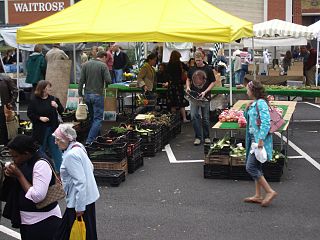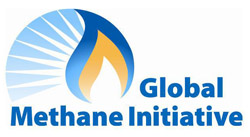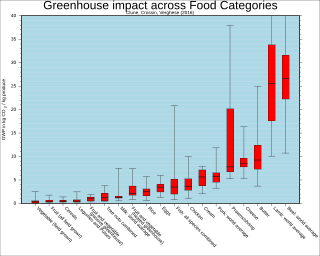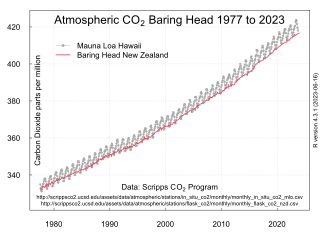Related Research Articles
Emissions trading is a market-based approach to controlling pollution by providing economic incentives for reducing the emissions of pollutants. The concept is also known as cap and trade (CAT) or emissions trading scheme (ETS). Carbon emission trading for CO
2 and other greenhouse gases has been introduced in China, the European Union and other countries as a key tool for climate change mitigation. Other schemes include sulfur dioxide and other pollutants.

Local food is food that is produced within a short distance of where it is consumed, often accompanied by a social structure and supply chain different from the large-scale supermarket system.
Carbon neutrality refers to achieving net-zero carbon dioxide emissions. This can be done by balancing emissions of carbon dioxide with its removal or by eliminating emissions from society. It is used in the context of carbon dioxide-releasing processes associated with transportation, energy production, agriculture, and industry.

In agriculture, grazing is a method of animal husbandry whereby domestic livestock are allowed outdoors to roam around and consume wild vegetations in order to convert the otherwise indigestible cellulose within grass and other forages into meat, milk, wool and other animal products, often on land unsuitable for arable farming.
The agricultural emissions research levy was a controversial tax proposal in New Zealand. It was first proposed in 2003 and would collect an estimated $8.4 million annually from livestock farmers, and which would have been used to fund research on the livestock industry's emissions of greenhouse gases, to further the nation's compliance with the Kyoto Protocol.

Climate change mitigation consists of actions to limit global warming and its related effects. This involves reductions in human emissions of greenhouse gases (GHGs) as well as activities that reduce their concentration in the atmosphere. It is one of the ways to respond to climate change, along with adaptation.

The European Union Emissions Trading System (EU ETS), was the first large greenhouse gas emissions trading scheme in the world. It was launched in 2005 to fight global warming and is a major pillar of EU energy policy. As of 2013, the EU ETS covers more than 11,000 factories, power stations, and other installations with a net heat excess of 20 MW in 31 countries—all 27 EU member states plus Iceland, Norway, Liechtenstein and United Kingdom. In 2008, the installations regulated by the EU ETS were collectively responsible for close to half of the EU's anthropogenic emissions of CO2 and 40% of its total greenhouse gas emissions. By 2020 the EU hopes to cut greenhouse gas emissions by 20% compared with 1990 and to increase energy efficiency by 20%. A 2020 study estimated that the EU ETS had reduced CO2 emissions by more than 1 billion tons between 2008 and 2016 or 3.8% of total EU-wide emissions.

The Global Methane Initiative (GMI) is a voluntary, international partnership that brings together national governments, private sector entities, development banks, NGOs and other interested stakeholders in a collaborative effort to reduce methane gas emissions and advance methane recovery and use as a clean energy source. National governments are encouraged to join GMI as Partner Countries, while other non-State organizations may join GMI's extensive Project Network. As a public-private initiative, GMI creates an international platform to build capacity, development methane abatement strategies, engage in technology transfer, and remove political and economic barriers to project development for emissions reduction.

Food miles is the distance food is transported from the time of its making until it reaches the consumer. Food miles are one factor used when testing the environmental impact of food, such as the carbon footprint of the food.

Federated Farmers of New Zealand is a lobby and advocacy group for farmers and rural communities. It has a network of 24 regional organisations and six industry groups. Federated Farmers lobbies on farming issues both nationally and within each region. Membership of the organisation is voluntary, and at 2021 it has over 13,000 members.

Environmental vegetarianism is the practice of vegetarianism when motivated by the desire to create a sustainable diet that avoids the negative environmental impact of meat production. Livestock as a whole is estimated to be responsible for around 18% of global greenhouse gas emissions. As a result, significant reduction in meat consumption has been advocated by, among others, the Intergovernmental Panel on Climate Change in their 2019 special report and as part of the 2017 World Scientists' Warning to Humanity.

The Indian Institute of Petroleum (IIP), established in 1960, is one of the constituent laboratories of the Council of Scientific and Industrial Research (CSIR), dedicated to R&D in the hydrocarbon sector.

Livestock's Long Shadow: Environmental Issues and Options is a United Nations report, released by the Food and Agriculture Organization (FAO) of the United Nations on 29 November 2006, that "aims to assess the full impact of the livestock sector on environmental problems, along with potential technical and policy approaches to mitigation". It stated that livestock accounts for 18% of anthropogenic greenhouse gas emissions, a figure which FAO changed to 14.5% in its 2013 study Tackling climate change through livestock.
A low-carbon diet refers to making lifestyle choices related to food consumption to reduce resulting greenhouse gas emissions (GHGe). Choosing a low carbon diet is one facet of developing sustainable diets which increase the long-term sustainability of humanity.
The environmental impact of meat production varies because of the wide variety of agricultural practices employed around the world. All agricultural practices have been found to have a variety of effects on the environment. Some of the environmental effects that have been associated with meat production are pollution through fossil fuel usage, animal methane, effluent waste, and water and land consumption. Meat is obtained through a variety of methods, including organic farming, free range farming, intensive livestock production, subsistence agriculture, hunting, and fishing.

Climate change in New Zealand is changes in the climate of New Zealand in relation to global climate change. In 2014, New Zealand contributed 0.17% to the world's total greenhouse gas emissions. However, on a per capita basis, New Zealand is a significant emitter – the 21st highest contributor in the world and fifth highest within the OECD.

The Pastoral Greenhouse Gas Research Consortium (PGGRC) carries out research to find methods of reducing greenhouse gas emissions from livestock. The consortium, established in 2004, has a Memorandum of Understanding with the New Zealand Government. Almost half of the greenhouse gas emissions in New Zealand are due to agriculture and since the New Zealand government has signed and ratified the Kyoto Protocol methods are being sought to seek a reduction of these emissions.

The environmental impact of agriculture is the effect that different farming practices have on the ecosystems around them, and how those effects can be traced back to those practices. The environmental impact of agriculture varies widely based on practices employed by farmers and by the scale of practice. Farming communities that try to reduce environmental impacts through modifying their practices will adopt sustainable agriculture practices. The negative impact of agriculture is an old issue that remains a concern even as experts design innovative means to reduce destruction and enhance eco-efficiency. Though some pastoralism is environmentally positive, modern animal agriculture practices tend to be more environmentally destructive than agricultural practices focused on fruits, vegetables and other biomass. The emissions of ammonia from cattle waste continues to raise concerns over environmental pollution.
Abatement cost is the cost of reducing environmental negatives such as pollution. Marginal cost is an economic concept that measures the cost of an additional unit. The marginal abatement cost, in general, measures the cost of reducing one more unit of pollution.

Approximately 40% of primary energy is from renewable energy sources in New Zealand. Approximately 80% of electricity comes from renewable energy, primarily hydropower and geothermal power.
References
- ↑ "Leading the way to pastoral emissions reductions" (Press release). New Zealand Government. 27 November 2007. Retrieved 22 August 2009.